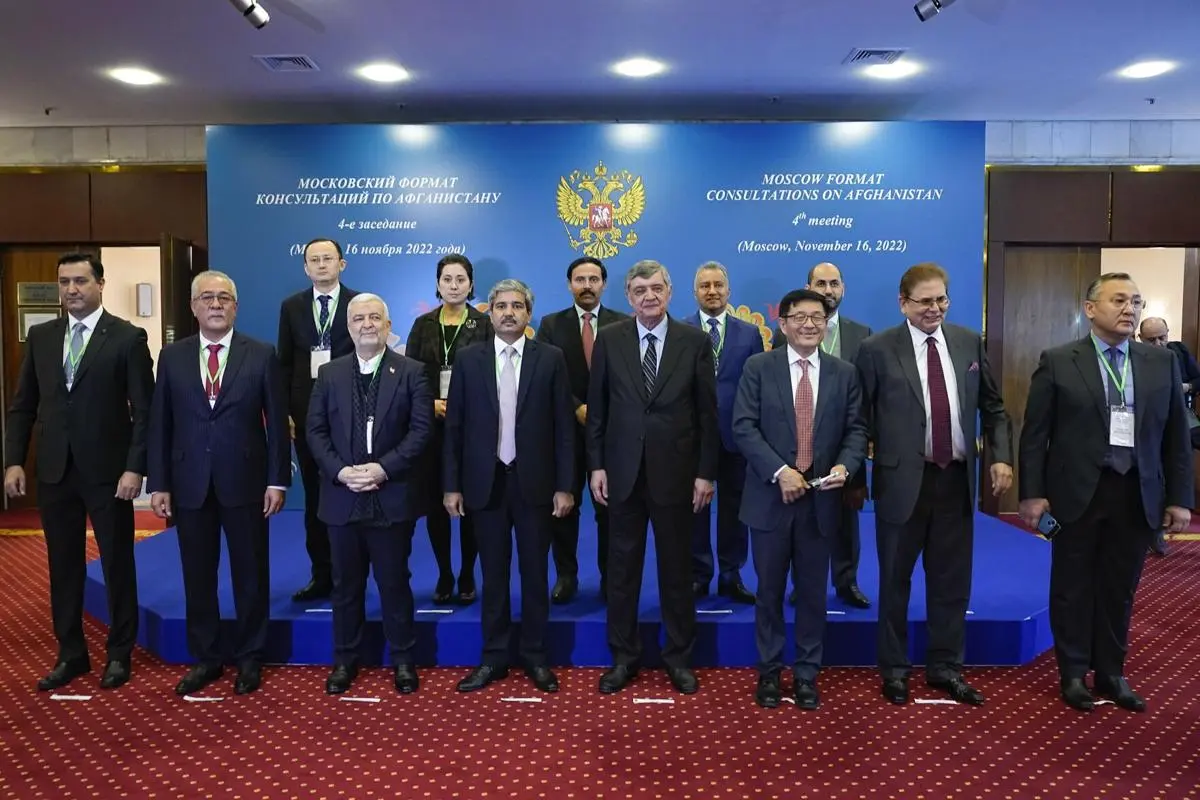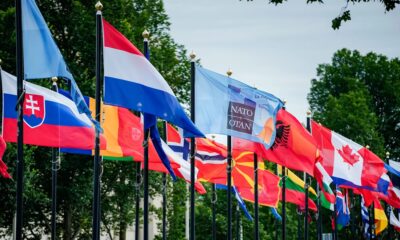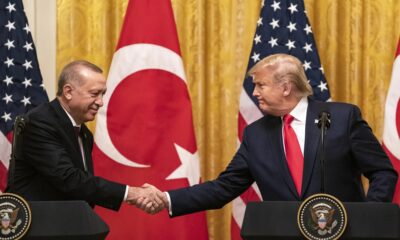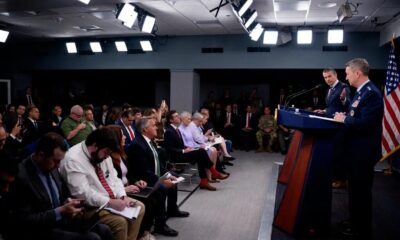Asia
Moscow Format pushes for reconciliation

Amidst growing tension with the Taliban interim-government, over border traveling restrictions, Pakistan has adopted a policy towards Afghanistan. On one hand, Pakistan has endorsed the global community’s reservations over Taliban policies, especially restrictions against women, growth in opium production and others but on the other it is insisting the international community for extending maximum support to Taliban regime. Even, Pakistan still confirms that, “footprint of terrorist organizations in Afghanistan, has yet to be fully eradicated,” remarked Pakistan’s Special Envoy to Afghanistan Muhammad Sadiq Khan while addressing the 4th Meeting of the Moscow Format Member States at Moscow Russia on Wednesday.
The summit attended by a number of countries, considered stakeholders to long standing conflict in Afghanistan has discussed in depth current situation of that country, which despite tall claims on the part of global community still ahead with un-ending internal hostilities and external plots and aggressions. The conference was held after two days of armed clashes in Chaman, Balochistan, considered the second most busy crossing point between Pakistan and Afghanistan. As a result of tension erupted with losses to precious human lives from both sides in the encounter, all sorts of traveling and economics have been on halt for the last several days. Hundreds of million rupees fresh fruits and vegetables, loaded in trucks have been gotten, thus further fuelling hate and anger amongst the local traders from both sides.
Pakistan supports meaningful dialogue and engagement in Afghanistan
Sadiq Khan, considered the most experienced diplomat, especially on Afghanistan in his well explained presentation before participants of Moscow Format has pointed out, “Pakistan is a firm adherent to the primacy of a regional approach to the situation in Afghanistan. We believe that the Moscow Format advances this goal, by bringing together the regional countries in a process of meaningful dialogue and engagement on Afghanistan. We met in Moscow last year at a time of great flux – the precipitous withdrawal of international forces from Afghanistan created a ‘vortex’ of uncertainty. As the international community considered ways and means to stand down from Afghanistan, we, the friends and neighbors of Afghanistan, stood up for the people of Afghanistan.”
Ironically, Sadiq has confirmed the creation of ‘vortex of uncertainty’ with withdrawal of the international community last year in mid August but he had ignored the jubilation of what Pakistan military establishment jubilated ‘fall of Dr. Ashraf Ghani regime and entrance of its sponsored Taliban to Kabul.’ No one is doubtful about the sincerity of Ambassador Sadiq Khan who is interested in political resolution to the long standing conflict and cordial friendly relations between Islamabad and Kabul but the military establishment has a different approach-based on influencing all sorts of internal and external policies of Afghanistan.
Afghanistan and Afghans are the victims of war
Discussion and stock of suggestions made in Moscow Format us similar to that discussed or exchanged in UN and other global or regional forums since the days of war in Kabul, erupted with former Soviet Union troops landing in Afghanistan in December 1979 last. In the early years, almost all US led allies who remained partners in war against the Soviet Union from the soil of Afghanistan remained one and same but later they adopted strategies of its choices-mostly conflicting with each other. And such conflicting strategies have no posing adverse impacts on no other than Afghanistan and its people, now considered ‘victims of an unwanted war or turmoil.
No doubt to mention that at once, US was distancing from Tehrik Taliban Afghanistan after erupting in-fighting amongst self-styled commanders of Peshawar made Jehadi groups and factions. But later, Talibanisation enabled the US to return and embark on so-called war on terror from the soil of Afghanistan. The US later made a successful attempt of getting “entrance” into the Taliban project, thus materializing its dreams eliminating al-Qaeda head Osama Bin Laden on one side and getting access to Pakistan’s modus operandi through Quetta Shura of Taliban Tehrik on the other.
The US, the Taliban and the two former Presidents of Afghanistan
Though the US in the light of guerrilla type resistance soon after commencing of war on terror, went for revision of its policies but it got the final touches after ending of Republican President George W. Bush tenure. Rifts or divisions amongst the Afghan leadership, especially between President Ashraf Ghani and Hamid Karzai, enabled the US to strengthen its links with Taliban through its trustworthy Qatar, considered second most loyal and close to the Americans after Saudi Kingdom. All couldn’t disagree with the fact that through guerrilla war, Taliban had failed in capturing a single inch in any part of Afghanistan but they succeeded in building up pressure against President Ghani through Doha Accord. Ex-President Hamid Karzai had also helped in mounting pressure against Ghani by attending all sorts of parlay in Doha, and Moscow.
Now that the Taliban succeeded in establishing its rule over Afghanistan, its top leaders, especially those called as Kandaharis are distancing themselves from Pakistan. Besides others, tension, clashes and shuttering on Chaman and Torkham crossing points are the order of the day. Alleged US drone attack on August 1st 2022 last, targeting al-Qaeda leader Ayman al-Zawahiri, has disheartened no other than the Haqqanis. Reshuffling in the military establishment made in the beginning of the second week of August has also posed bad impacts on links between Taliban and Pakistan.
Moscow Format pushes for human rights and political reconciliation
Ambassador Sadiq Khan in his presentation has successfully highlighted hardships of Taliban regime and miseries of common Afghans but at the same time, he also endorsed the international community demands from Interim government (Taliban) regarding“ i). promoting inclusivity, ii), respecting fundamental human rights including rights of women, (iii) countering terrorism, and (v) sustained support to the Afghan people including provision of humanitarian and economic support.” But showing Pakistan’s disappointment, Sadiq Khan maintained, “the progress report of the last sixteen months is mixed – while some of the worst fears including a rapidly deteriorating security situation in Afghanistan, mass exodus of refugees and a prolonged period of instability and violence did not materialize, the Interim Afghan Government has also not made the kind of progress that the international community would ideally expect.” In particular about honoring the international community’s demand for inducting other politico-communal groups in government, Sadiq Khan remarked, “nowhere is this more apparent than on the question of ‘inclusiveness’. The international community has consistently urged the Interim Afghan Government to promote greater political inclusivity. Unfortunately, there is little to show on this count.”
Violation of women rights and grave humanitarian crisis
Likewise, is Pakistan’s disappointment over violation of women rights and girls education as pointed out by Sadiq Khan, “despite assurances by the Interim Afghan Government, the rights of women and girls also appear to have regressed, not progressed.” He further said the footprint of terrorist organizations in Afghanistan, has yet to be fully eradicated. But he also pointed out failure of international community as saying, “this ‘cascade’ of unmet expectations, has unfortunately meant that critical support needed by Afghanistan to stave-off a grave humanitarian crisis, prevent an economic meltdown and to combat terrorism, have also faltered.” Insisting on the global community’s early support, Pakistan special envoy said, “millions of Afghans are in desperate need of urgent humanitarian support including food, medicine and essential life supplies. The advent of the Afghan winter has exacerbated an already dire situation – the World Food Program has already warned that over half the Afghan population could face a ‘winter of famine’ this year.”
Though Sadiq Khan as an experienced diplomat made a well explained presentation in Moscow Format but internally Kabul is unhappy on stock of issues. Like the 90’s when Mullah Omar Akhund and the then acting Prime Minister Mullah Rabbani have refused to sign Pakistani documents regarding Durand Line, similar is the response of present set up in Kabul. Almost all top Taliban leaders in their internal meetings and chats are showing severe resentment over Pakistan policies. The Taliban soldiers are in wait of opportunities for erecting the fenced wars, installed with financial support at different points of Durand Line.
Participants of Moscow Format calls on US to unblock Afghan asset
Following the Moscow Format of consultations on Afghanistan, Russia, China, Pakistan, Iran, India, Kazakhstan, Kyrgyzstan, Tajikistan, Turkmenistan and Uzbekistan resolutely demanded that the US should completely unfreeze the Afghan assets.
The Russia Foreign Ministry said that a strong call was made to the US and NATO countries responsible for their 20-year military presence in Afghanistan to compensate for the damage inflicted on the Afghans in the past several years.
The participants also discussed the importance of forming a truly inclusive government in Afghanistan, reflecting the interests of key ethno-political groups, as well as the need to eradicate terrorist, drug and other threats emanating from this country.
All the sides reached an agreement to continue coordinating regional efforts to promote inter-Afghan national reconciliation, strengthen security and stability in the region under the auspices of the Moscow format of consultations on Afghanistan.
Four countries, Qatar, the United Arab Emirates, Saudi Arabia and Turkey attended the event as guests.
The Moscow Format on Afghanistan was established in April 2017, in which 11 countries mentioned above have shown interest to be part of the format to discuss the situation in Afghanistan. However, the Taliban did not attend the meeting this time.
Asia
Chinese navy chief and top nuclear scientist expelled from legislature

The chief of staff for the People’s Liberation Army (PLA) Navy, Vice Admiral Li Hanjun, and Liu Shipeng, the deputy chief engineer of the state-owned China National Nuclear Corporation, were removed from their positions in the country’s legislative body.
Li is the latest in a series of PLA generals and a handful of defense industry executives implicated in a widespread investigation within the military.
In a statement on Friday, the NPC Standing Committee announced, “The Navy Soldiers’ Congress has decided to remove Li Hanjun from his post as a representative to the 14th National People’s Congress.”
The Gansu People’s Congress also dismissed Liu Shipeng from his role as an NPC deputy.
Additionally, the Standing Committee revealed it had voted to remove Miao Hua, a former top general who previously oversaw the PLA’s ideological work, from the Central Military Commission (CMC), China’s highest military command body led by President Xi Jinping.
The removal of Li and Liu from their NPC memberships suggests they are facing serious disciplinary action.
China typically remains silent about purges within the military, and announcements from the NPC are one of the few indicators of such campaigns.
There is little public information available about Li and Liu, as both have worked in sensitive positions.
Before becoming the navy’s chief of staff, Li, 60, was the deputy director of the CMC’s Training and Administration Department. He was appointed to this role after serving for a year in the CMC’s Office for Reform and Organisational Structure.
In 2014, he was promoted to vice admiral upon his appointment as commander of the naval base in Fujian province, where Miao also spent a significant part of his career. At that time, he was the director of training at the China Naval Command College and was soon promoted to president of the school.
According to official media reports, nuclear scientist Liu was born into a family that “served China’s nuclear dream for three generations.”
As the deputy chief engineer at CNNC, which oversees all aspects of China’s civil and military nuclear programs, Liu also served as the Communist Party secretary and president of CNNC’s “404 base” in Gansu.
Covering an area of over 1,000 square kilometers, the base was established in 1958 and is the country’s first and largest nuclear research center. It played a crucial role in the development of China’s first atomic bomb in 1964 and its first hydrogen bomb three years later.
This secretive base is still considered a key hub for China’s nuclear deterrence and nuclear industry.
According to statements from provincial authorities, Liu was named “Gansu’s outstanding entrepreneur” in 2023.
Asia
China, US reach agreement on export controls

The Chinese Ministry of Commerce announced on Friday afternoon that Beijing and Washington have remained in close contact since the two-day trade talks in London earlier this month, confirming the details of a framework agreement.
“China will review and approve export applications for controlled items in accordance with its laws and regulations, and the US side will, in turn, lift a series of restrictive measures against China,” the ministry stated.
“We hope the US side will cooperate with China in line with the important consensus and conditions established during the conversation between the two presidents on June 5,” the statement continued.
On Thursday, US President Donald Trump said the US had “signed” a trade deal with China the previous day, without providing details.
“We signed the deal with China yesterday, right? We signed the deal with China,” Trump said at a White House event introducing a budget law. “With the China deal, we are starting to open up China,” he added.
He also mentioned that a “very big” deal, likely with India, would be signed soon.
Rare earth elements
Following the event, US Commerce Secretary Howard Lutnick told reporters that the US and China had signed an agreement codifying the terms decided upon in previous trade negotiations.
“They will deliver rare earth elements to us,” Lutnick said in a televised interview with Bloomberg, adding that if this commitment is fulfilled, Washington will lift its “countermeasures.”
Rare earth elements, essential for producing high-tech products, including those for the defense industry, were a major point of contention in the trade talks. China holds a near-monopoly on the supply of these minerals due to its massive share of global refining capacity.
Responding to a question on Thursday about rare earth exports, ministry spokesman He Yadong said China had approved a “certain number” of applications and would “continue to strengthen” the review and approval process for eligible applications.
He added that Beijing is willing to “strengthen communication and dialogue” with other countries on export controls and actively promote appropriate trade.
Lutnick also stated that the US plans to reach agreements with 10 major trading partners in the coming weeks. The deadline for countries to negotiate trade terms before higher tariffs are reinstated was July 9, following a 90-day suspension of import tariff hikes announced on April 2.
The two negotiating teams concluded the London talks by announcing they had agreed “in principle” on a “framework” that both sides would take home for their respective leaders to review, as they sought to get their uneasy truce, signed last month in Geneva, back on track.
The negotiations began after a highly anticipated phone call between Xi Jinping and Trump, which seemingly ended an intractable stalemate.
In the weeks following the initial agreement in Switzerland, Washington claimed China was restricting exports of critical minerals, while Beijing reacted to US restrictions on semiconductors and threats to impose visa barriers on Chinese students.
Asia
China hosts SCO defense ministers on warship amid regional tensions

Chinese Defense Minister Dong Jun hosted his Iranian counterpart and other high-level defense officials from Shanghai Cooperation Organisation (SCO) member states aboard an advanced Chinese warship, just days after the US bombed Iran’s nuclear facilities.
Iranian Defense Minister Aziz Nasirzadeh was among the defense officials welcomed by Dong on a military vessel in the coastal city of Qingdao, China, as part of a two-day SCO defense ministers’ meeting that concluded on Thursday.
According to Chinese state television CCTV, Nasirzadeh and other defense officials toured the People’s Liberation Army (PLA) Navy’s Type 052D destroyer, the Kaifeng, and later attended a reception on the ship’s deck.

Aboard the ship, Nasirzadeh thanked Beijing for “supporting Iran’s legitimate position following the recent attacks” by Israel and the US.
“We hope that China will continue to stand on the side of justice, help maintain the current ceasefire, and play a greater role in de-escalating regional tensions,” Nasirzadeh said, according to Xinhua.
In his address to the assembled ministers, Dong reportedly stated that “unilateralism, protectionism, and hegemonic and bullying acts are on the rise, seriously disrupting the international order and becoming the greatest source of chaos and conflict.”
Dong called for closer cooperation within the United Nations, the SCO, and other multilateral frameworks, urging members to unite with “more like-minded forces” to defend international justice and maintain global stability.
“SCO countries must remain true to the organization’s founding ideals, uphold the ‘Shanghai Spirit,’ and deepen practical cooperation in all areas,” Dong said. “With stronger actions, we can jointly safeguard a peaceful environment for development,” he added.
The event followed the US attacks on three of Iran’s key nuclear facilities on Saturday, which Beijing strongly condemned.
The Chinese Foreign Ministry stated that the attacks on nuclear facilities under the supervision of the International Atomic Energy Agency seriously violated the UN Charter and its principles.
Additionally, the SCO meeting coincided with a NATO leaders’ summit in The Hague. In a statement from The Hague, US President Donald Trump announced that the US would hold talks with Iran about a possible nuclear deal “in the coming week.”
Bilateral Talks
According to Xinhua, the Chinese defense minister later held separate bilateral meetings with the defense ministers of Belarus, Pakistan, Kyrgyzstan, and Russia. The state news agency reported that all parties appreciated Beijing’s efforts and significant contributions to developing SCO operational mechanisms and deepening inter-sectoral cooperation during its rotating presidency. They also expressed a strong will to further consolidate and expand military ties.
Pakistani Defense Minister Khawaja Asif praised Beijing’s role in de-escalating tensions. “Pakistan highly values its robust friendship with China and is ready to work together to implement its three global initiatives, deepen military cooperation, and help maintain regional peace and stability,” he said.
For Russian Defense Minister Andrei Belousov, this year—the 80th anniversary of the victory in World War II, the Chinese people’s war of resistance against Japanese aggression, and the world’s anti-fascist war—presents an opportunity to deepen bilateral military relations. “In line with the consensus of our leaders, we will intensify strategic communication and cooperation and contribute to global strategic stability,” he said.
Meanwhile, Indian Defense Minister Rajnath Singh also attended the Qingdao meeting. This marked the first visit by an Indian defense minister to China since the deadly border clash between the two countries in 2020.
Military trust
According to the Chinese Ministry of Defense, the SCO defense ministers’ meeting is one of the key events held during China’s rotating presidency of the SCO this year. The ministers, along with representatives from the SCO and regional anti-terrorism bodies, gathered to further strengthen military trust and deepen practical cooperation among member states.
The SCO, a 10-nation bloc comprising China, Russia, Kazakhstan, Kyrgyzstan, Tajikistan, Uzbekistan, Pakistan, India, Iran, and Belarus, currently covers approximately three-fifths of the Eurasian continent and about 43% of the world’s population.
The Beijing meeting, held under the rotating presidency of the Shanghai Cooperation Organisation, highlighted China’s role as a significant international actor and the importance Tehran places on its relationship with Beijing, even as China has largely remained on the sidelines of the Israel-Iran conflict.
During a regular press conference at the Chinese Ministry of Defense on Thursday, when asked if Beijing was considering providing military support to Iran as an SCO member, ministry spokesman Zhang Xiaogang told CNN, “China is ready to cooperate with all parties to play a constructive role in maintaining peace and stability in the Middle East.”
Kaifeng destroyer
The Kaifeng destroyer, where the meeting’s reception was held, is the sixth vessel of the extended Type 052D variant and serves in the North Sea Fleet. Commissioned in April 2021, the ship is approximately 159 meters (521 feet) long, weighs 7,500 tons, and is equipped with 517C anti-stealth radar. Its expanded deck allows for the landing of the PLA Navy’s Z-20 helicopters.
The warship has conducted numerous long-range exercises, including a passage through the Tsushima Strait in April, as part of Beijing’s growing operational presence in the western Pacific.
It was publicly displayed during the 74th-anniversary celebrations of the Chinese navy in Qingdao in 2023.
-

 Diplomacy2 weeks ago
Diplomacy2 weeks agoNATO summit focuses on arms race in the Silicon Valley age
-

 Europe2 weeks ago
Europe2 weeks agoIsrael-Iran conflict postpones EU plan for Russian oil sanctions
-

 Europe2 weeks ago
Europe2 weeks agoGermany to expand military with 11,000 new personnel this year
-

 Diplomacy2 weeks ago
Diplomacy2 weeks agoErdoğan to meet Trump at NATO summit to mend relations
-

 Diplomacy2 weeks ago
Diplomacy2 weeks agoIranian foreign minister travels to Moscow for Putin talks after US strikes
-

 Middle East2 weeks ago
Middle East2 weeks agoUS bombs Iranian nuclear sites, sparking fears of wider conflict
-

 America2 weeks ago
America2 weeks agoPentagon divided over military priorities in Asia and the Middle East
-

 Diplomacy2 weeks ago
Diplomacy2 weeks agoGerman arms industry expands presence in India amidst geopolitical shifts


















